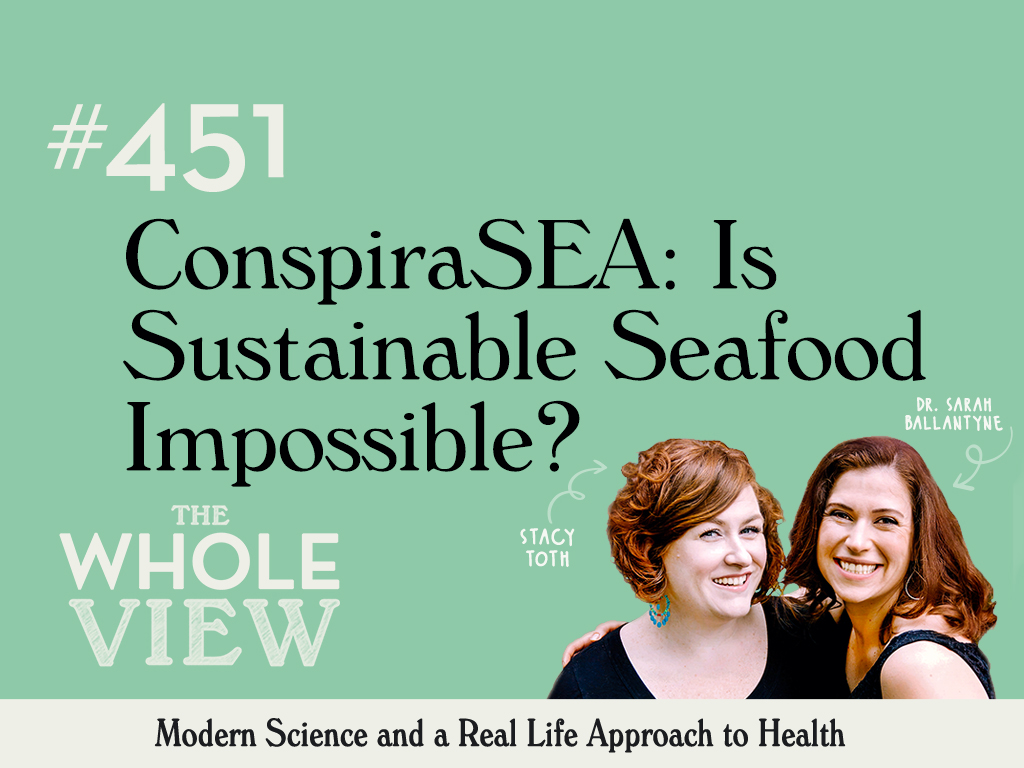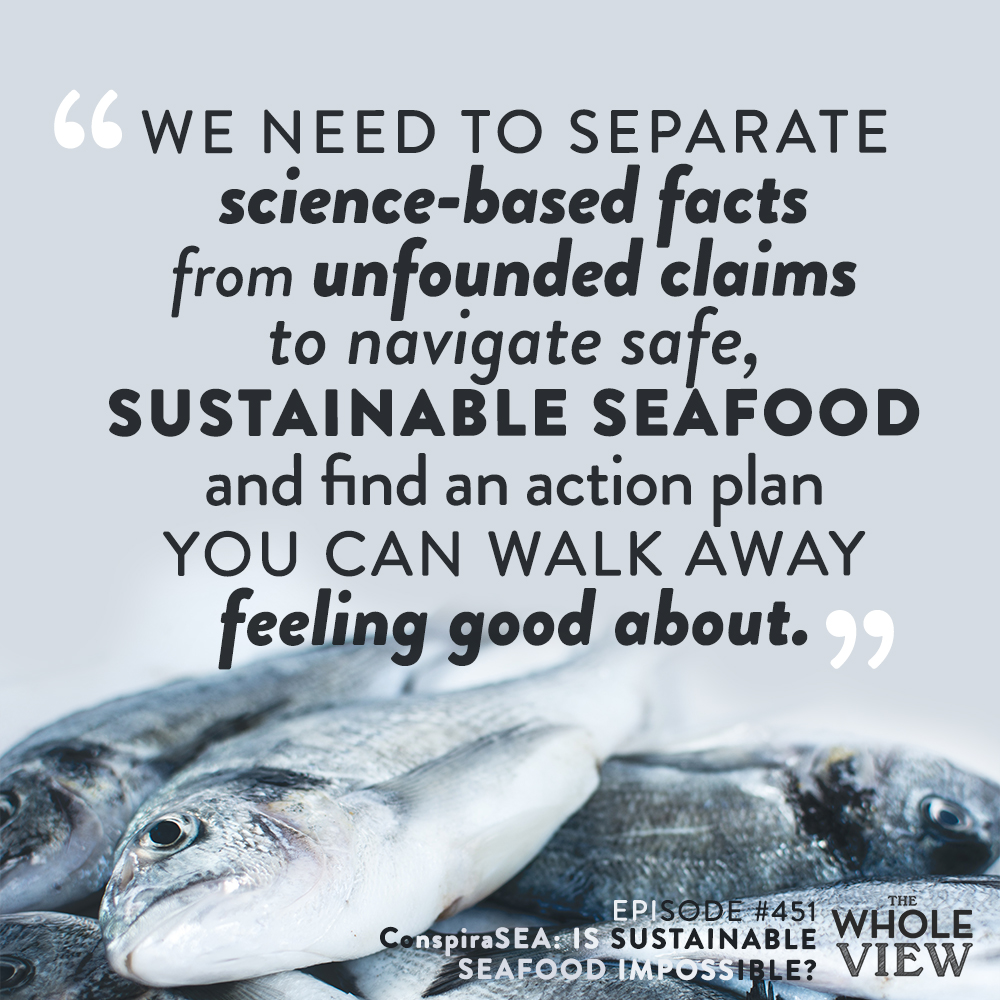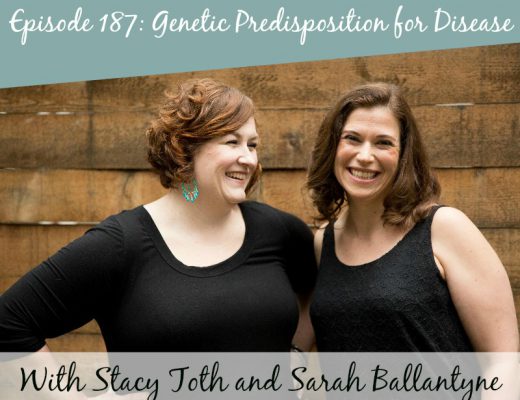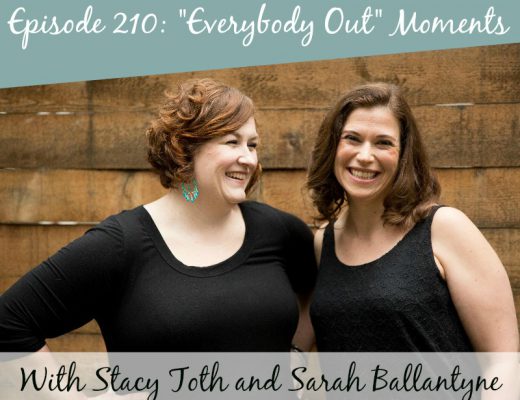 Welcome to episode 451 of The Whole View! This week, Stacy and Sarah address the health benefits, the question of sustainable seafood and Seaspiracy as a whole. They take a deep dive into the fishing industry to answer whether or not the film’s claims regarding sustainability is accurate, and more.
Welcome to episode 451 of The Whole View! This week, Stacy and Sarah address the health benefits, the question of sustainable seafood and Seaspiracy as a whole. They take a deep dive into the fishing industry to answer whether or not the film’s claims regarding sustainability is accurate, and more.
If you enjoy the show, please review it on iTunes!
The Whole View, Episode 451: ConspiraSEA: Is Sustainable Seafood Impossible?
Welcome back to episode 451! (0:28)
Stacy and Sarah have received many questions on Netflix new documentary, Seaspiracy.
Stacy took almost eight pages of notes, while Sarah has also prepared many sea-related puns for you.
First off, the name ConspiraSEA was right there, and she totally feels they missed the boat (ha!) on that one.
Stacy also mentions they gathered thirteen pages between them to ensure you are provided with as much information as possible and not just Stacy and Sarah’s opinions.
The message the show tries to deliver is the opposite of this show’s top recommendations.
Stacy could tell within minutes that the filmmakers had an agenda. She and Sarah plan to review the science-based facts from the claims made in the film.
The goal is to help listeners navigate safe, sustainable seafood because despite what the film attempts to present, seaweed and plant-based options do not compare to the health benefits.
So Stacy and Sarah want to dive right in. (Get it?)
Benefits of Seafood
It’s important to emphasize what we’d be missing out on if the premise that sustainable fishing is impossible is true. (4: 01)
Eating more seafood can reduce cardiovascular disease and prevent obesity and diabetes.
High amounts of vitamins, minerals, carotenoids, fats, and protein all contribute to these benefits. (Intro to Nutrivore)
Fish is a great source of vitamins B1, B2, B3, B6, B9, B12 and E, zinc, phosphorus, magnesium, iron, copper, potassium and selenium. Oily, cold-water fish provide substantial amounts of vitamin A and vitamin D as well.
Fish with bones remaining (such as canned salmon and sardines) are the best dietary sources of calcium in the food supply. Marine fish are an excellent dietary source of iodine.
High Selenium Content
- protect against some cancers,
- enhance bone health,
- maintain thyroid health,
- reduce the risk of infection,
- assist in DNA production, and
- protect the body from free radical damage
Omega-3 Fats EPA and DHA
- reduce inflammation,
- lower blood pressure,
- protect against some cancers (including breast),
- increase insulin sensitivity, and
- improve endothelial function
- Improves gut microbiome composition
Salmon
Or any fish with a similar salmon-pink or orange color also contains the antioxidant carotenoid astaxanthin.
- helps reduce LDL oxidation
- boosts HDL levels, and
- protects against skin damage.
Fish protein is the BEST!
Also supports a healthy, diverse gut microbiome (in addition to omega-3s) – better than any other protein source: beef, pork, chicken, soy, casein, and pea. (11:20)
Many fish benefits are mediated via protein, and fish protein is easy to digest.
In a meta-analysis of five prospective cohort studies, lean whitefish’s high consumption reduced the risk of stroke by 19% (which was even more than fatty fish intake, which reduced stroke risk by 12%).
A study of Swedish women shows that three servings of lean fish per week reduced the risk of stroke by 33% compared to zero servings per week.
In Norwegian men, weekly lean fish consumption (including whitefish) was associated with a lower risk of metabolic syndrome, lower triglyceride levels, and higher HDL cholesterol.
Likewise, a randomized crossover trial found that simply adding 100 grams per day of whitefish (Namibia hake) to the diet significantly lowered waist circumference, diastolic blood pressure, and LDL levels!
And another trial found that eating 150 grams of cod per week caused significantly greater weight loss in young overweight adults than a same-calorie diet without seafood.
Seaspiracy “Documentary”
Sarah poses the question: what if eating fish and shellfish is destroying the ocean ecosystem and is actually full of toxins? (17:30)
This is what Seaspiracy claims, so let’s talk about this propaganda.
Stacy reminds us documentaries are a filming style, and the information contained within is not regulated.
They can be amazing ways to learn about history or science. They can also be manipulative propaganda. So just because it’s in documentary format does not mean it’s news or that it’s true.
This documentary was made by the same people who made What the Health and Cowspiracy.
We don’t want to get into a point-by-point discussion but let’s bust the two biggest myths purported by this documentary:
Sustainable Seafood Claims
The “movie” claims that there’s no such thing as sustainable seafood what so ever. Commercial fishing is destroying the oceans.
They claim fisheries aren’t regulated, and fish farms are even worse. Also, the proportion of fish sold in the U.S. is caught illegally, and the “”sustainably caught label is meaningless.
The second claim is that we should all be vegan. Seafood is full of toxins (like mercury and PCBs) and microplastics. It’s destroying the oceans, and we can get the same nutrients from algae.
What is Sustainable Fishing?
Sarah adds that her first research job in college was research for the Canadian Department of Fisheries and Oceans. (22:01)
It entailed actually doing research for sustainable salmon fishing. They even published a paper based on her research!
The United States is recognized as a global leader in sustainable seafood because we rely on strong science, responsive management, and enforced compliance.
Fish, shellfish, and marine algae are renewable resources because they reproduce and replenish their populations naturally.
That means we can sustainably harvest fish within certain limits without depleting their populations.
Sustainability has two basic steps:
- Scientists perform a stock assessment to recommend how much fish should be harvested.
- Fishery managers and regulators follow and enforce that recommendation.
Fishery management uses science to determine these limits and entails catching some fish while leaving some to reproduce and replace the fish that are caught.
What It Means For Sustainability
The United States is actually a global leader in seafood sustainability in general. Interesting enough, Stacy notes the “documentary” left this detail out entirely. (25:03)
The argument centers around that our global population are rising, but our global abundance of wild fish is not.
Food and Agriculture Organization of the U.N. (FAO) estimates that 66% of fisheries are sustainable, contributing 78.7% of consumed seafood.
This means there’s room for improvement since 20% of the fish eaten in the world are from overfishing.
However, this doesn’t mean give up on fish. It means you need to be an informed consumer!
One of the amazing things about our oceans is that fish stocks can recover and replenish if they are managed carefully for the long term.
Some stocks that have come back from the brink include the Patagonian toothfish in the Southern Oceans.
Other examples include the recovery of Namibian hake, after years of overfishing by foreign fleets, or the increase in some of our major tuna stocks globally.
Research shows that fish stocks that are well-managed and sustainable are also more productive in the long term. This means there is more seafood for our growing global population.
Outlying Scientific Data on Sustainable Seafood
In 2006, a study predicted a global collapse of fish species and empty oceans by 2048. However, it was later busted here: https://sustainablefisheries-uw.org/fisheries-2048/
Stacy adds that while watching the “documentary,” she noted all the studies referenced were at least 5 years old.
Sarah mentions that when she comes across studies considered “outliers” and goes against most other data, she looked a bit closer at the details.
Nowadays, we’re seeing many of these “outlier” articles being overly weighted and fueling pseudoscience claims on the internet.
She notes that it doesn’t mean that they are necessarily wrong. We just need to look a bit more critically at the science to figure out what exactly is happening.
Commercial Fishing is Highly Regulated
Stacy notes one important aspect she learned from the “documentary” is that people can be bribed anywhere. (38:06)
She adds that given details in contrast to the “documentary” agenda can be cut out to strengthen the case.
Because bribery exists, the “documentary” claims you can’t believe anything anyone in the industry says. However, they fail to provide any instances of this so-called bribery.
Commercial fishing is not equivalent to CAFO’s or industrial farming. All it means is catching fish to sell.
It can be done large scale, but the industry is highly regulated. In fact, U.S. fishermen abide by some of the most rigorous environmental measures in the world.
Both large and small scale fishing boats are regularly inspected to ensure fisheries are protected, and we’re abiding by sustainable seafood guidelines.
Fishery management in the United States is guided by several laws, including the Magnuson-Stevens Act, Marine Mammal Protection Act, and Endangered Species Act.
10 national standards of sustainability manage U.S. fisheries. These standards aim to prevent overfishing, protect other species and habitat, and minimize bycatch on non-target species.
It is the case that some fish sold in the U.S. were caught elsewhere.
If you’re looking to uphold sustainability, ensure you shop local or see where the fish was caught, or the fishery is located.
It’s important to note that the main economy of Pacific island nations is fishing. So outlawing the sustainable seafood industry would result in their economy’s collapse.
Farm Fishing Isn’t Evil
Stacy notes one claim the “documentary” makes is that fish farms have a “organic waste” (aka the fish poop in the water). (51:35)
Fish poop is not a toxic substance and used as food for organisms like algae.
Aquaculture, or farming in water, plays a critical role in ensuring that our need for seafood is met sustainably. It’s also a resource-efficient way of increasing and diversifying U.S. seafood production.
The future of sustainable seafood must include both farm-raised and wild-capture seafood!
Increasingly, seafood farming (if done responsibly as it is in the United States) is recognized as one of the most environmentally sustainable ways to produce food and protein.
We discussed antibiotics use and “coloring” in farmed fish in Episode 366: Seafood Safety Concerns.
Sarah notes there’s a mandatory withdrawal period for each type of antibiotic fed to fish before the fish can be slaughtered. So, there is ample time to make sure there’s no residuals in the meat by the time we eat them.
Additionally, the dye used is actually astaxanthin: the same red carotenoid pigment found in red algae makes wild fish flesh that distinctive color. It’s an important antioxidant and makes them healthier!
Because of feed ingredients, the nutrient profile of farmed fish usually isn’t as good as wild. But, it’s still a great choice!
Marine Stewardship Council Certification
At Whole Foods, the seafood counter displays blue labels from the Marine Stewardship Council (MSC), an international, nonprofit organization. (58:52)
The MSC is a prime example of an economic trend: private groups, not the government, tell consumers what is good or bad for the environment.
The MSC says its label guarantees that the wild seafood was caught using methods that do not deplete the natural supply.
It also guarantees that fishing companies do not cause serious harm to other life in the sea, from coral to dolphins.
Unilever and the World Wildlife Fund joined hands in 1997 to establish MSC as an independent not-for-profit, more than 20 years ago over concerns about overfishing,
This certification process is not carried out by the MSC. It is independent and carried out by expert assessment bodies. Also, it’s an entirely transparent process, and NGOs and others have multiple opportunities to provide input.
All the assessments can be viewed online at Track a Fishery.
Only fisheries that meet the rigorous requirements of Standard get certified.
Check out their rebuttal to Seaspiracy here!
Other labels to look for:
- The Monterey Bay Aquarium labels products like a traffic light — green, yellow or red — to urge shoppers to buy or avoid a particular fish.
- The Blue Ocean Institute has a similar system.
- The Tuna Tracking and Verification Program (TTVP), established under the Dolphin Protection Consumer Information Act, is how NOAA Fisheries monitors compliance with dolphin-safe tuna labeling. (Reference)
- What about the BAP cert for responsibly farmed fish?
This topic is very important to Sarah and Stacy, and they want to make sure they’re supporting the right companies and share this with listeners for their own knowledge.
Conspiracies
The “documentary” claims that sustainably sourced labels are lies and all dishonest. (1:12:20)
It was organized in a very manipulative way where it starts with a fact but shows footage as a representative that isn’t a fact.
Stacy shares these examples:
Fact: enough single-line is used daily to wrap around the world 500x.
- This does not mean that much line is discarded into the ocean daily- just used.
- It’s phrased as though it’s being dumped in the ocean every day, which it’s not.
- In fact, single line fishing is a good thing!
Fact: 250,000 sea turtles are “captured, injured, or killed” in U.S. annually from fishing vessels.
- When fact-checked, you realize that that number includes the ones returned to the ocean after capture or healing from injury.
- This species is protected now, so many are rescued and returned.
- However, the “documentary” conveniently leaves that out to manipulate the impact of the number.
Sarah adds that we are biologically herbivores (solely plants) or carnivores (solely meat) but omnivores. This means our body is designed to gain nutrients from a combination plant and meat diet.
Fish Toxins
Can’t we just eat algae? No- it’s not the same as seafood. By this logic, we’d get the same nutrients eating grass that we do from eating beef.
Stacy and Sarah did a whole episode on it: TPV Podcast Episode 366: Seafood Safety Concerns.
There have been a few European studies showing a U-shaped response curve to fish consumption. Moderate fish consumption reduces all-cause mortality and cardiovascular disease risk. However, higher fish consumption increases the risk of all-cause mortality.
The studies have postulated that this may be due to increased exposure to some of the toxins that can accumulate in fish. These toxins include methylmercury, dioxins, and polychlorinated biphenyls (PCBs)
However, this isn’t seen in North American or Asian cohorts studies where fish is equally as likely to contain these toxins.
The authors of a rigorous 2017 meta-analysis proposed an alternate explanation for a U-shaped curve in Europe. Traditional preparations of fish in many parts of Europe include deep-frying, pickling, or salting.
This high-salt and/or trans-fatty acid intake may be to blame for the higher all-cause mortality seen with higher fish consumption.
What about microplastics?
We’ve talked about single-use plastics on the show before in TPV Podcast Episode 352: Sustainability & Mother Earth.
Also, Sarah has written about it here: https://www.thepaleomom.com/my-journey-towards-zero-waste/
Plastic pollution is a problem! They did get that right. For more information on this, see articles here and here. But solving this problem doesn’t include avoiding seafood (buy sustainably caught).
Look to lower your carbon footprint, reduce the use of single-use plastics, avoid cycling, recycle properly, and look to reusable bags and containers.
There are better ways to learn about how to protect our oceans:
- Planet Earth documentary
- Blue Planet
- Nova
- National Geographic
- Scientific American magazine
Where Do Stacy and Sarah Get Fish?
My favorite source is ButcherBox https://www.butcherbox.com/thepaleoview
Stacy has a local fishmonger at farmer’s market, plus Costco, Trader Joe’s – tons of vendors now sell Alaskan and/or certified sustainable seafood
Farmed shrimp, Alaskan / farmer’s market salmon, dolphin-safe line-caught tuna, local shellfish
Great Resources
- https://sustainablefisheries-uw.org/start-here/
- https://www.fisheries.noaa.gov/feature-story/5-things-you-should-know-about-sustainable-seafood
- https://www.msc.org/media-centre/news-opinion/news/2021/03/26/response-to-netflix-seaspiracy-film
- https://pubmed.ncbi.nlm.nih.gov/31932439/
- https://oceanservice.noaa.gov/facts/microplastics.html
Final Thoughts
Sarah reminds listeners that documentaries are not grounded in scientific fact and can be skewed. (1:31:40)
The truth is the oceans are in trouble and need help, just not wholly in the ways stressed in the “documentary” Seacpiracy.
We need to look at this practice to find an action we can walk away with feeling good about.
If you haven’t joined the Patreon family yet, joining supports this podcast and provides you with bonus content on what Stacy and Sarah really feel.
Thank you so much for listening, and we’ll see you next week!





